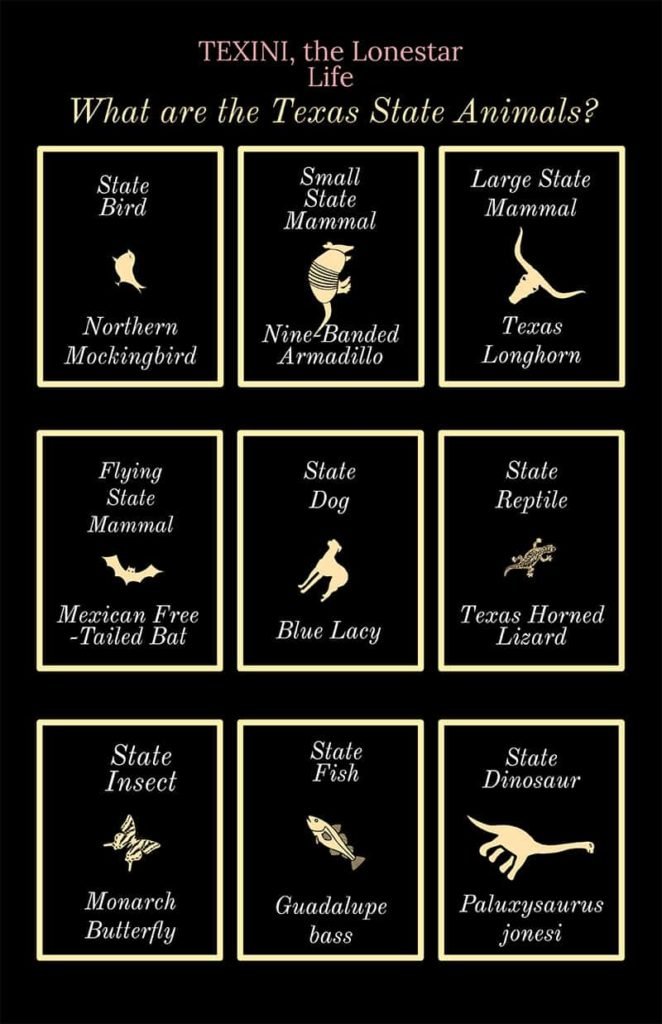Official symbols of Texas include animals designated by senate resolution. What are the Texas State Animals? The Texas State Animals include the northern mockingbird, nine-banded armadillo, Texas longhorn, Mexican free-tailed bat, Blue Lacy, Texas horned lizard, Monarch butterfly, Guadalupe bass, and the Paluxysaurus jonesi.
The State Bird of Texas
The state bird of Texas is the northern mockingbird (Mimus polyglottos); a medium-sized songbird with a natural habitat that spans the entire state from the desert, and mountains to the cities. The mockingbird was adopted as the state bird of Texas in 1927. The mockingbird’s song is a combination of many birds as it mocks or mimics other bird calls.
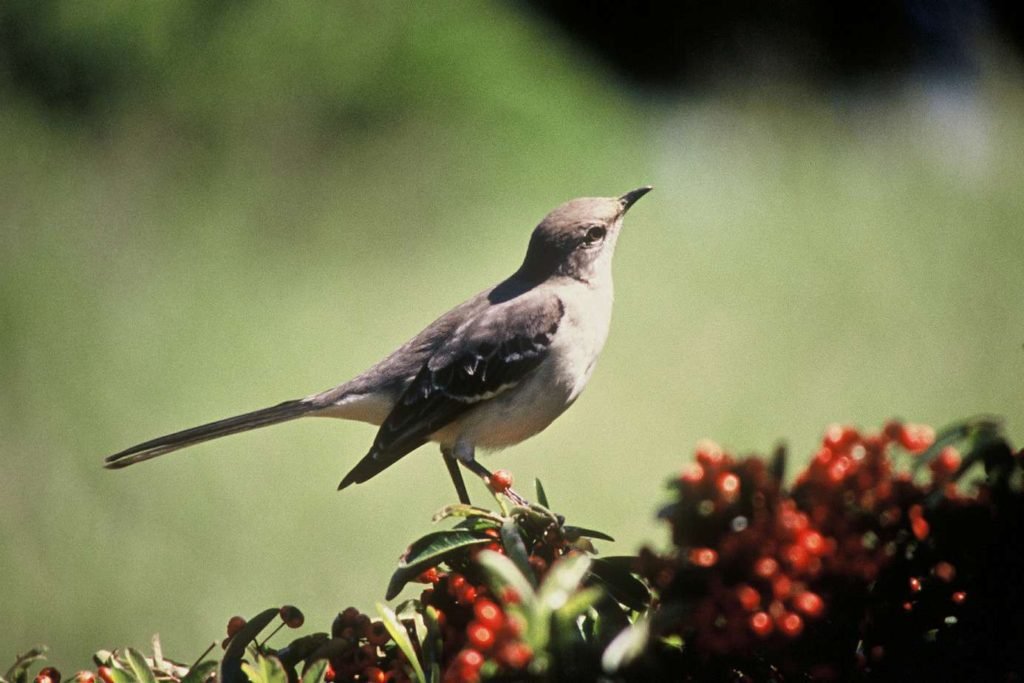
The Mimus polyglottos means, many-tongued mimic, referring to the mockingbird’s innate ability to perfectly mimic the songs of dozens of other bird species. The mockingbird can mimic many sounds including honking horns, barking dogs, and musical instruments.
Mockingbirds breed in early summer and spring. Mockingbirds are monogamous paring for life and can live up to 20 years. Mockingbirds are naturally defensive birds and have been known to attack other animals in defense of their chicks.
Per Texas Senate Concurrent Resolution No. 8 in part states:
“WHEREAS, Ornithologists, musicians, educators, and Texans in all walks of life unite in proclaiming the mocking bird the most appropriate species for the state bird of Texas, as it is found in all parts of the state, in winter and in summer, in the city and in the country, on the prairie and in the woods and hills, and is a singer of distinctive type, a fighter for the protection of his home, falling, if need be, in its defense, like any true Texan;”
A law designating the mockingbird as the official Texas state bird as stated in Section 3101-007 (STATE BIRD) of the Texas Statutes, GOVERNMENT CODE specifically Title 1 (GENERAL PROVISIONS) Chapter 3101 (STATE SYMBOLS) Section 3101-007.
The State Small Mammal of Texas
The state small mammal of Texas is the nine-banded armadillo (Dasypus novemcinctus). There are approximately 20 different varieties of armadillo worldwide. The nine-banded armadillo is the only one found in the United States. The armadillo prefers a warm climate and is primarily found in the southern US. However, with climate changes, it has progressively been spotted as far north as Illinois. The nine-banded armadillo typically has seven to eleven bands on its armor. The armadillo’s armor consists of a bony, scaled shell that helps to protect them from their predators.
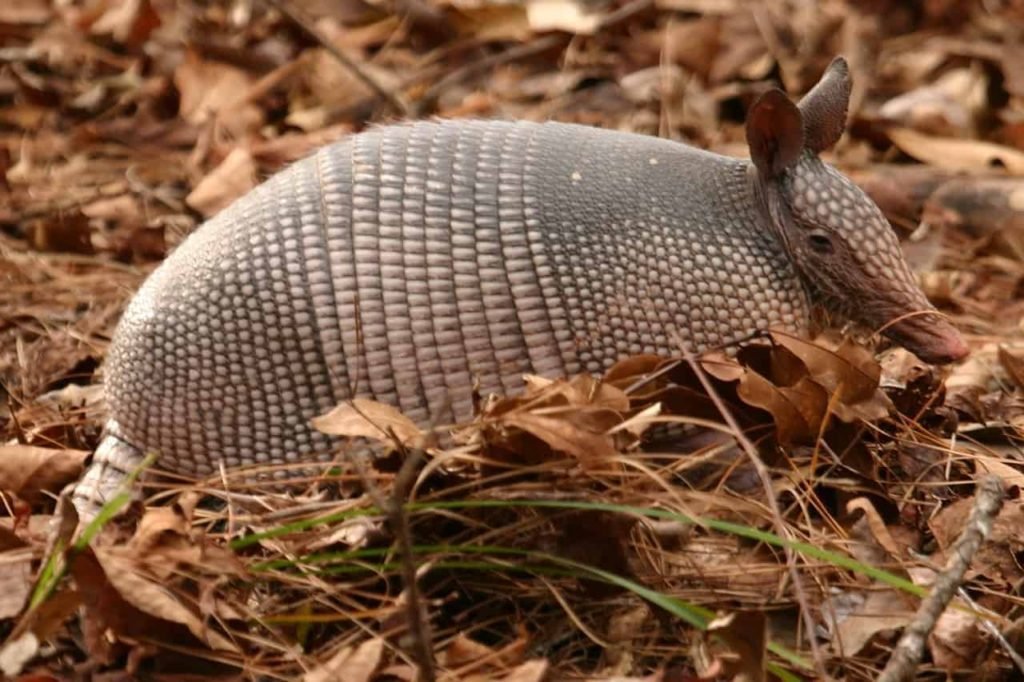
Armadillos are largely insectivorous but sometimes eat smaller animals, fruit, and fowl eggs. Armadillo racing is a popular pastime in Texas. Armadilloes can carry leprosy also called Hansen disease a chronic infectious disease.
Armadilloes are nocturnal animals that can sleep up to 19 hours per day. Armadillos burrow for shelter and dig for food. The Armadillo prefers forest and shrubby terrains. Armadillos breed once a year and the female armadillo gives birth to four identical quadruplets. Armadillos do not mate for life; they are polygynous. The State of Texas designated the armadillo as the official Small State Mammal of Texas in the House Concurrent Resolution No. 178.
The Large State Mammal of Texas
The large state mammal of Texas is the longhorn. The Texas longhorn is a hybrid breed brought about by mixing Spanish Criolla and English cattle. In 1964 a longhorn registry was created through the Texas Longhorn Breeders Association of America.

In the 1850’s Texas ranchers headed longhorns to markets in the north to bring in more money. In 1927 the Texas longhorn was near extinction due to cross-breeding. Small herds of longhorn were then designated to reside in Texas State Parks and since that time has become popular with Texas ranchers. The Texas longhorn is hardy, adaptable, and growing in popularity as a viable gene pool for breeding as well as a great natural resource having stood the test of time. The Texas longhorn represents the American Cowboy, Texas ranchers, and Texas historical past.
The Texas longhorn is known for its expansive horns which can reach 80 to 120 inches. The Texas longhorn can survive in almost any condition, finding food and shelter during times of rough weather and even drought. The longhorn is prized for its lean beef which is lower in fat, calories, and cholesterol than most cattle.
The Texas Longhorn has become an iconic symbol representing our vibrant cultural heritage and tough Texas ruggedness; “gitter-done spirit”. The Texas Longhorn was officially adopted as Texas’s large state mammal on June 16, 1995, when Governor George W. Bush signed House Concurrent Resolution No. 178.
The Texas Flying State Mammal
The Texas flying state mammal is the Mexican free-tailed bat (Tadarida brasiliensis Mexicana). It was adopted as the Texas state flying mammal on May 25, 1995. Mexican free-tailed bats prefer to roost in caves but will also take refuge under bridges, vacant buildings, and attics preferably near water. They have forward-pointing ears, and are typically gray and brown. Bat colonies can be over 20,000,000. They have strong legs and are adept at climbing.

The Mexican free-tailed bat (Tadarida brasiliensis Mexicana) is also known as the Brazilian Free-tailed bat. It is one of the most numerous mammals in North America. A popular roost housing approximately 1.5 million bats are located underneath the Congress Street Bridge in Austin, Texas. In the summer hundreds of tourists gather around dusk to watch the bats fly out from under the bridge. These bats can consume 10,000 to 20,000 pounds of insects daily.
The largest bat colony roost is Bracken Cave located northwest of San Antonio. This location is the world’s largest bat colony and one of the largest communities of mammals on Earth. They can fly 60 miles per hour at altitudes over 10,000 feet. Female bats give birth to one pup between the first and third week of June. Bats are prey to many animals. Colonies of bats leave their roosts each night to feed on mostly flying insects. They can eat the equivalent of their body weight in one feeding. Free-tailed bats usually travel in groups
The State Dog of Texas
The state dog of Texas is the Blue Lacy which was adopted officially as the Texas state dog on June 18, 2005, SENATE RESOLUTION NO. 436.

Lacy’s carry a rare blue gene but can also be red and multicolored. The Blue Lacy is the only dog to originate as a breed in the state of Texas.
The Blue Lacy was developed by the Lacy brothers in Burnet County Texas in the mid-1800s. The Blue Lacy is thought to have been bred from greyhounds, coyotes, and scent hounds. Blue Lacys were common to ranchers for herding cattle, hogs, and chickens. They were also used as drovers and hunting dogs almost becoming extinct when their use as working dogs declined.
They are medium-sized dogs with short coats. Blue Lacy has become quite popular as a hunting dog as well as in search and rescue efforts. They make excellent guard dogs and companions for energetic experienced dog owners. Lacy’s carry a rare blue gene but can also be red and multicolored. The Blue Lacy is the only dog to originate as a breed in the state of Texas.
The Blue Lacy is full of energy, intelligence, and hardiness. Easily trained they make great family dogs but do not do well as apartment dwellers and need a high-energy owner to socialize, and spend quality time with them. They are working dogs and well suited to ranch or farm life. They are happiest when they have a job to do!
The Texas State Reptile
The Texas state reptile is the Texas Horned Lizard (Phrynosoma cornutum). The Texas horned lizard is a species of Squamata in the family of North American spiny lizards. The hatchlings must find food and defend themselves against predators immediately after hatching because no care is provided by the parents. The Texas Horned Lizard is a threatened species. The Texas horned toad uses its skin to direct water into its mouth, keeping it hydrated.
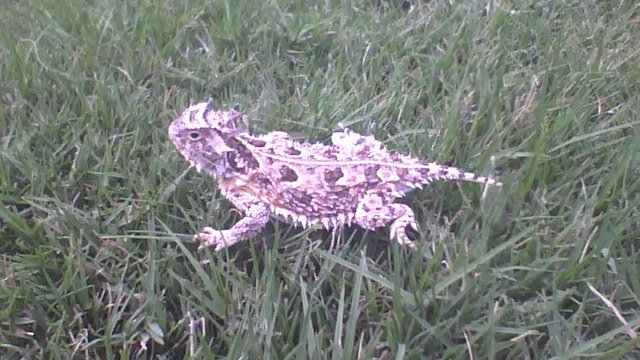
Growing up in Texas it was enormous fun to spot a “horny toad” as we kids called them. They were more plentiful back in the day. Today they are considered endangered and at threat of disappearing. The best time to spot a Texas Horned Lizard is in the morning and evening. During the heat of the day, they seek shelter under rocks, vegetation, and crevasses. This practice also provides shelter from predators.
The Texas Horned Lizard as its name suggests is covered with horny spikes. The largest spikes are on their heads. Female horny toads are generally larger than males of the species. Their color helps them blend into the ground. During mating season, they are a bit more colorful. The breeding season of the horny toad begins immediately after hibernation in April and continues through the middle of June. The female digs a tunnel to lay her eggs in.
The Texas Horned Lizard can make their bodies flat or inflated with air depending on the circumstances. As a kid, we would often prod them with a stick to make them inflate since they do this when they sense danger. This iconic Texas lizard always seemed rather mystical and was rarely seen with other horny toads. Smaller less mature horny toads were easier to catch if you could bring yourself to pick one up. You knew you were having a good day if you spotted a Texas Horned Lizard!
As a last resort, the Texas Horned Lizard will shoot blood from its eye sockets when threatened. I never witnessed this phenomenon myself but had friends who swore they had seen it happen. The blood actually comes from the ocular sinuses, tissues found just below the eye. The horned lizard has two constricting muscles that line the major veins around its eye. When they contract these muscles it cuts off the blood flow back to the heart allowing it to flow into the head. This floods the ocular sinuses with blood and as the lizard contracts these muscles in a rapid manner, the thin sinus membranes rupture. This creates a jet stream of blood that can shoot up to four feet from the eye socket.
The Texas Horned Lizard was an integral part of my childhood and the children of my generation growing up in Texas. My children and grandchildren have never seen one in its natural habitat. The San Antonio Zoo began a project in 2017 to bring back the Texas Horned Lizard. They are focusing on reintroducing the Texas Horned Lizard in Central and South-Central Texas Counties. This effort includes Bexar, Bandera, Blanco, Comal, Hays, Kendall, and Kerr counties. For more information visit here.
The Texas Horned Lizard was adopted as the Texas state reptile on June 18, 1993. It was placed on the threatened species list in 1967 and it still remains there today.
The Texas State Insect
The Texas state insect is the beautiful Monarch Butterfly (Danaus plexippus). This has always been a personal favorite of mine and even though I may not always know the time frame for the monarch migration in my area; once it is here it is impossible to miss. The monarch butterfly migrates nearly 2,500 miles southward each year to find a warmer home for the winter. The State of Texas is its last trek on this journey where it rests and feeds before it travels to the mountains of Mexico for winter.
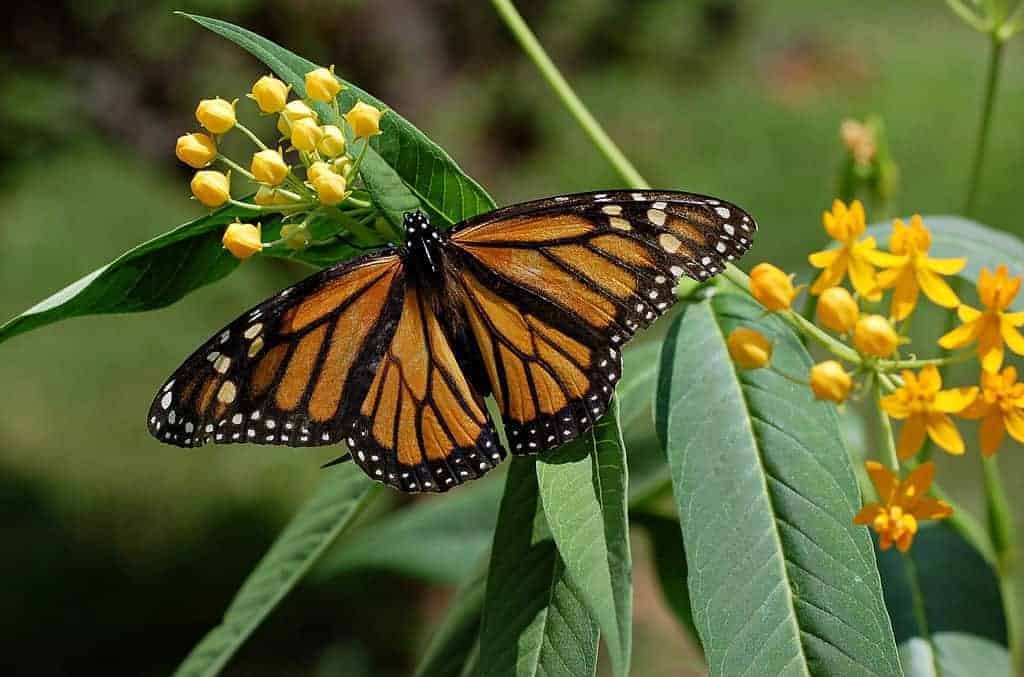
A typical year of monarch migration has brought from one billion – 450 million to the state of Texas on their journey to Mexico however in recent years Texas native milkweed has decreased. Since milkweeds are crucial to the survival of the monarch butterfly, Texas has seen a decrease in the migration numbers of the monarch butterfly. Texas has seen a sharp decrease in this number down to approximately 30 million a year. The decrease in native milkweed, where the Monarch lays their eggs on their migration north from Mexico in the spring is largely responsible. Farmers and urban city planners’ overuse of pesticides is upsetting our natural ecosystem making survival for the monarch butterfly very difficult.
In addition to declining natural habitats being decreased by the overuse of pesticides, millions of monarchs are killed by automobiles traveling down the highway every year. The I-35 corridor is also a major, critical breeding, wintering, and migration corridor for the monarch butterfly. We can all do a little something to correct this injustice to one of North America’s most majestic insects. To attract more of this beautiful butterfly to your home incorporate native and adaptive plants in your garden to create a habitat for monarchs and other pollinators.
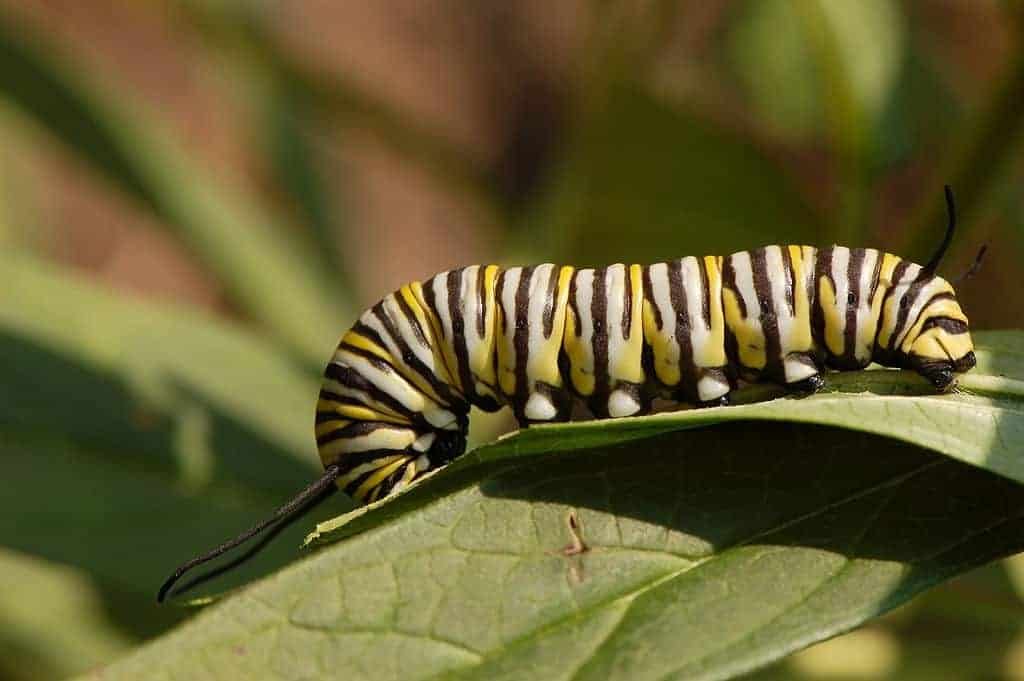
Monarch caterpillars need milkweed plants to grow and develop into butterflies. In March and April, their eggs are laid on milkweed plants. They hatch into baby caterpillars, also called larvae. They eat and grow rapidly in only 10-15 days. Adult monarchs need nectar to provide energy and sustain them for their migratory journey. Planting native milkweed plants in your garden will make an impact on their survival along with nectar-bearing eco-friendly plants. If we all do our part this beautiful majestic butterfly will again thrive.
The monarch butterfly became the official butterfly of the State of Texas when Governor George W. Bush signed House Concurrent Resolution No. 94 on June 16, 1995.
The Texas State Fish
The Texas state fish is a Guadalupe bass (Micropterus treculii). Weighing in at less than 3.5 pounds the average Guadalupe bass is the baby cousin of the black bass. However, this spunky fish puts up a hard fight and is popular among fly fishermen. The Guadalupe bass is a native fish naturally found in the waters of the Edwards Plateau and lower Colorado rivers. Like many native Texas wildlife, the Guadalupe bass has seen a reduction in numbers due to dams and pollution.

Conservation achievements for Guadalupe bass through Texas Parks and Wildlife are ensuring that the next generation of anglers will have the opportunity to pursue them as well. Efforts are ongoing to restore the Guadalupe bass to its namesake Guadalupe river as well as the San Gabriel River. Other Texas rivers are designated for future conservation efforts of restoring the Guadalupe bass to its natural habitat.
To Texans, the Guadalupe is a bass like no other. Texas designated the Guadalupe bass as the official state fish in 1989.
The Texas State Dinosaur
The Texas state dinosaur is what? You say? Yes, our state dinosaur is the Quadrupedal Sauropod, (Paluxysaurus jonesi), who knew? Right. Texas is one of 8 states in the US that has chosen to honor ancient creatures that once roamed their land. Texas was home to over 20 kinds of dinosaurs. Texas dinosaurs lived during the Mesozoic Era from 248 to 65 million years ago.

The Sauroposeidon, (Paluxysaurus jonesi,) dinosaur measured 70 feet long and 12 feet high at the shoulder, and weighed as much as 20 tons. Their diet was herbivorous (plant-eating), they had tiny heads, massive bodies, very long necks, and long tails.
In 2009 the 81st Legislature of the State of Texas passed a concurrent resolution to amend the name of the Lone Star state dinosaur from the 75th Legislature of the State of Texas name – the Brachiosaur Sauropod, Pleurocoelus to the official Lone Star State Dinosaur name of (Paluxysaurus jonesi,) due to the name being misidentified in the 1997 resolution. Much fuss over ancient bones, who knew? Right.
In Conclusion
What are the Texas state animals? Official symbols of Texas include animals designated by Texas senate resolution being the northern mockingbird, nine-banded armadillo, Texas longhorn, Mexican free-tailed bat, Blue Lacy, Texas horned lizard, Monarch butterfly, Guadalupe bass, and the Paluxysaurus jonesi.
The Texas state animal armadillo and longhorn are both well-known animals that reside in the Lone Star State and now you know the rest of the story. The Texas state flying mammal, the Mexican free-tailed bat (Tadarida brasiliensis Mexicana), is a popular tourist attraction with several accessible viewing areas in various regions of the state. The Congress Avenue bridge in Austin, Texas has the largest urban bat colony in the world. Texas state animals and plants are just as diverse as its people and terrain. Visit often for more Texas Lifestyle including its fauna, flora, and wildlife.
Find out more about Texini, the leading Texas lifestyle brand that is defined by its celebration of the Lone Star State’s culture, heritage, and values.
Texini, Texas Lifetyle, Drinks & Foods, Crispy Asian Peanut Chicken Wings, recipe here.
Read about the Texas Blind Salamander here.
air fryer recipe areas in Texas areas of texas Austin Texas average cost of living in texas Bar-B-Cue Bar-B-Q Bar-B-Que barbecue barbeque bbq best cities in texas to raise a family best place to live in texas for families bowl of red budget-friendly meal cities in texas comfort food cost of living in texas easy appetizer easy dessert recipe easy dinner easy dinner recipe famous in texas Foods in Texas friendly people google texas county google texas news google texas roadhouse gulf of america leading texas lifestyle brand lifestyle brand local texas one-pot meal party food protein-rich meal Southern comfort food Southern cuisine Southern dessert Texas texas cooking Texas Hill Country texas lifestyle brand Texas Panhandle Texini the leading Texas lifestyle brand weeknight dinner
The Texas State Animals include the northern mockingbird, nine-banded armadillo, Texas longhorn, Mexican free-tailed bat, Blue Lacy, Texas horned lizard, Monarch butterfly, Guadalupe bass, and the Paluxysaurus jonesi.
Recent Posts
If you're ready for an easy, delicious Keto-friendly alcohol beverage drink then try this awesome Keto Colorado Bulldog!So easy and so delicious, you would never guess it is a keto diet...
Easy Homemade Keto Coffee liquor (one brand name is Kahlua) is so easy when using our method. Just be aware that the end product will have almost as much alcohol as the vodka you use, so amounts used...



